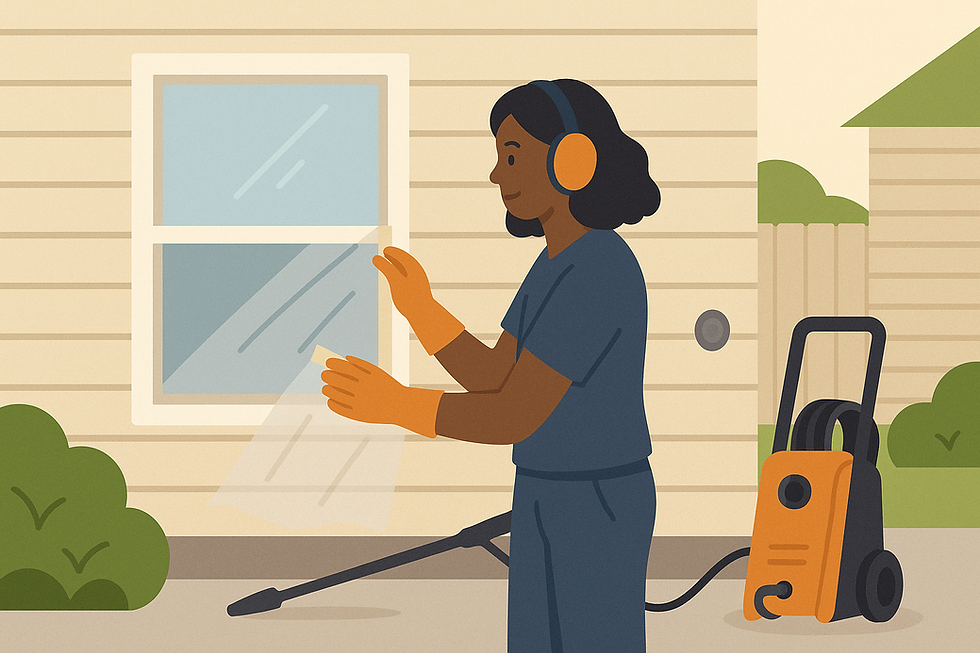Is Pressure Washing Safe for All Surfaces?
- robert4716
- Aug 12
- 3 min read
Pressure washing is a powerful and efficient way to clean outdoor surfaces, from house siding and driveways to decks and fences. But is it safe to use on all types of materials? The short answer: no—pressure washing is not safe for every surface. While it can quickly remove dirt, grime, mildew, and stains, using the wrong pressure setting or nozzle on delicate surfaces can cause costly damage.
In this blog post, we’ll explore which surfaces are safe to pressure wash, which ones require extra caution, and which should be avoided altogether.

What Makes Pressure Washing Potentially Harmful?
Pressure washers use highly pressurized water—sometimes as high as 4,000 PSI (pounds per square inch)—to blast away unwanted buildup. While this is excellent for tough jobs like cleaning concrete, it can easily damage softer materials like wood, stucco, and asphalt shingles if not used correctly.
Damage can include:
Etched or pitted surfaces
Stripped paint or protective coatings
Water forced beneath siding or roofing
Cracked or splintered wood
Understanding what surfaces can handle pressure and how to use the right tools makes all the difference.
Surfaces That Are Safe to Pressure Wash
1. Concrete and Brick
Concrete driveways, sidewalks, and brick patios are some of the safest surfaces to pressure wash. These materials are hard and durable, making them ideal for high-pressure cleaning. Just be cautious around older or crumbling mortar, which could be damaged.
2. Vinyl Siding
Vinyl is tough enough for pressure washing, but it’s best to use a medium pressure setting and a wide spray nozzle. Avoid aiming the stream upward, as water can get behind the siding and cause mold or rot.
3. Aluminum and Metal Surfaces
Gutters, metal roofs, and aluminum siding can be pressure washed using lower pressure to prevent dents. Be careful not to strip paint or protective coatings.
Surfaces That Require Caution
1. Wood (Decks, Fences, and Siding)
Wood is soft and can splinter under high pressure. Use a low-pressure setting and a fan tip nozzle to avoid damage. In many cases, soft washing (a low-pressure method with detergents) is a safer alternative.
2. Stucco
Stucco is porous and prone to cracking if pressure is too high. If cleaning stucco, use a gentle setting, keep the nozzle at a distance, and test a small area first. Soft washing is often the preferred method.
3. Windows and Glass
Never use high pressure on windows. The force can crack glass or damage seals. If you need to clean windows with a pressure washer, use a low-pressure nozzle specifically designed for this purpose.
Surfaces to Avoid Pressure Washing
1. Asphalt Shingles
Never pressure wash your roof unless it’s specifically made for it (like metal or tile). Asphalt shingles can lose their protective granules and become vulnerable to leaks.
2. Old Mortar or Crumbling Masonry
High pressure can easily break down weak mortar joints and worsen structural issues. It's better to hand-clean these areas or use a very gentle wash.
3. Stained or Painted Wood
Pressure washing can strip paint or stain, especially if it's already starting to peel. In most cases, repainting or staining is a better option than trying to "clean" with high pressure.
Final Thoughts
Pressure washing is a great tool—but like any powerful tool, it must be used correctly. Not all surfaces are created equal, and understanding which materials are safe to clean with high pressure will help you avoid costly repairs.
When in doubt, consult a professional or opt for soft washing—a method that uses lower pressure and cleaning agents to safely treat more delicate surfaces.
Want help deciding how to safely clean your home’s exterior? Reach out to our team for expert advice or to schedule a consultation!


